Quantum Computing Market Size, Share, Statistics and Industry Growth Analysis by Offering, Deployment (On-Premises And Cloud), Application (Optimization, Simulation, Machine Learning), Technology (Trapped Ions, Quantum Annealing, Superconducting Qubits), End User and Region - Global Forecast to 2029
[247 Pages Report] The quantum computing market will be valued at USD 1.3 billion in 2024 and USD 5.3 billion by 2029, growing at a CAGR of 32.7% during the forecast period.
The growth of quantum computing technology is divided into short-term, mid-term, and long-term terms. Companies in the quantum computing market are focusing on error reduction in the short term. The mid-term goal for quantum computing technology is to do error correction. In the long term, companies in quantum computing are expected to focus on the modification of the architecture of the technology. Quantum computing companies like IBM and Google, among others, have announced individual roadmaps toward developing quantum computing technology. From 2023, visionaries such as IBM plan to bring dynamic circuits to the Qiskit Routine to improve accuracy, reduce required resources, and create a scalable computation system by 2026. As of 2023, industries like automotive & transportation, healthcare and pharma, and financial services are a few of the industries that have adopted quantum computing for various applications. Like in financial services, quantum computing is used for derivative pricing, portfolio and trading optimization, and risk management, among others.
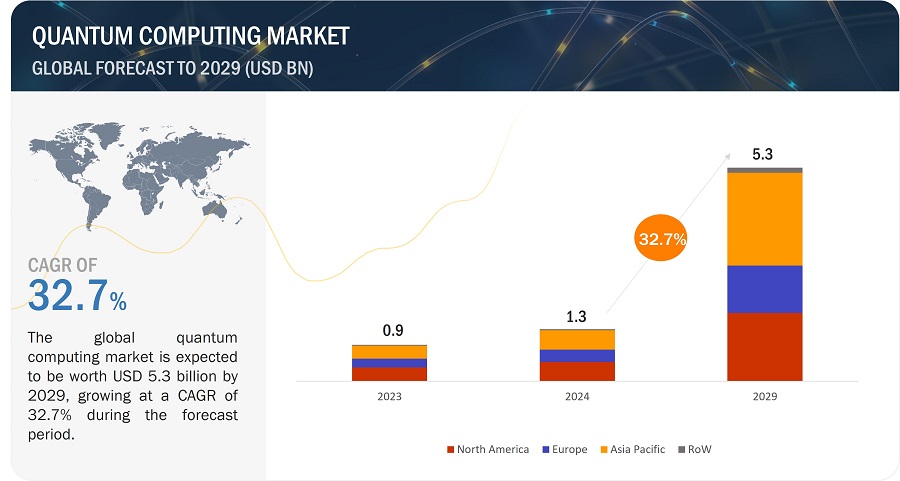
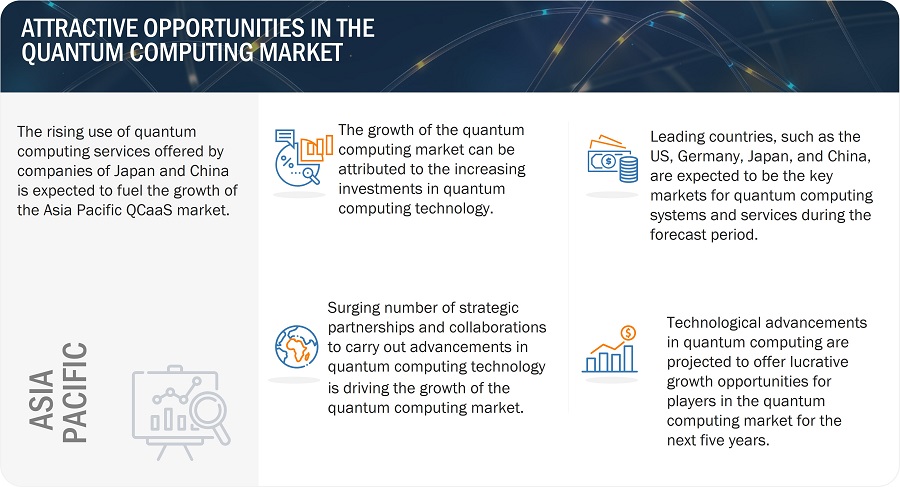
Quantum Computing Market Forecast to 2029
To know about the assumptions considered for the study, Request for Free Sample Report
Quantum Computing Market Dynamics
Driver: Rising investments in quantum computing technology
The ecosystem surrounding quantum computing is expanding rapidly. This technology has applications in geophysics, medical imaging, and navigation systems. Governments of countries like the US, Australia, and the European Union are working on quantum computing initiatives and investments. For instance, in January 2023, the government of Canada announced a plan to invest ~USD 355 million in initiatives to develop quantum talent, advance quantum technology applications, and commercialize quantum computing.
Restraint: Stability and error correction issues
Quantum computing is one of the fastest-growing technologies in the world, but some restrictions restrict its development. The information available in quantum computing is complex and difficult to keep stable. Like in classic computers, the information is either 0 or 1. But in quantum computers, the qubits exist simultaneously in a superposition of both states. This condition makes them suitable for errors from environmental noise and hardware imperfections.
Opportunity: Technological advancement in quantum computing technology
Quantum computing is a growing technology that has the opportunity to make computing faster. These devices can perform valuable tasks but have a high rate of error. In short-term quantum computing, use cases will have a hybrid quantum operating model, a mix of traditional and quantum computers. In the short term, also known as the NISQ era, the revenue for quantum computing will be entirely generated from end-user industries and research investments. Mid-term quantum computing is expected to witness many advantages over conventional computers. To achieve this stage, algorithms with a high error correction ability are required. Long-term quantum computing requires a high tolerance for error correction and scalability. At this stage, the value will be added by the hardware, software, and service providers.
Challenge: Shortage of quantum computing technology skilled working professional
Quantum computing technology is a growing technology. Technology development requires specialists who know quantum mechanics and have computer science and mathematics expertise. The professional should also understand quantum programming and machine learning, among other technologies, to keep up with the fast-growing field of quantum computing. Companies working in the field of quantum computing face the challenge of hiring talent with a good understanding of the technology, and hence, it is one of the significant challenges for the market.
Quantum Computing Market Map:
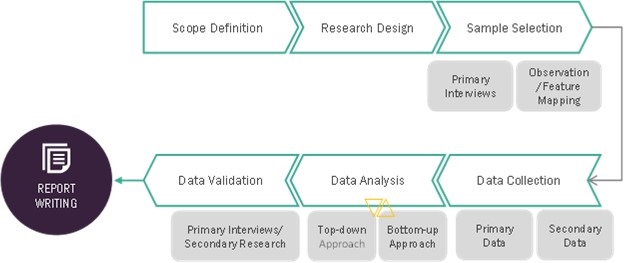
Systems segment to account for highest CAGR of the quantum computing market during the forecast period
Quantum computer systems are designed to solve complex problems that traditional computers find difficult. Constant investments and development in quantum computing systems are driving the market during the forecast period. Quantum computing hardware launches are becoming increasingly common. The shipment of quantum computing systems is increasing daily. For instance, in the year 2023, 2 quantum computers were shipped.
In recent years, many companies have released quantum computing hardware, including IBM, Google, Microsoft, Intel, and Rigetti Computing.
Cloud segment to register the highest market size during the forecast period.
The cloud segment is projected to account for a larger share of the quantum computing market than the on-premises segment from 2024 to 2029. Cloud quantum computing is a type of quantum computing technology that uses cloud computing to provide access to quantum processors and other quantum computing resources. Over the past decade, the enterprises that carry out data processing within their facilities have shifted a significant portion of their IT load to specialized cloud services such as Amazon Web Services, Microsoft Azure, and Google Cloud. A few enterprises are using the hybrid cloud that uses private computer resources belonging to enterprises and public cloud-based services.
The machine learning segment will have the highest CAGR in the quantum computing market during the forecast period
The market for machine learning technology is expected to have the highest CAGR during the forecast period. Machine learning in quantum computing is used to optimize its operations by solving complex problems faster than traditional computers. For instance, companies like IQBit (Canada) offer Optimization, Simulation, and Machine Learning Molecular Similarity (GMS) tools for virtual screening and assisting in drug discovery for pharmaceutical companies.
Asia Pacific to hold the largest share of the quantum computing market during the forecast period.
The demand for the quantum computing market is expected to have the largest share in the Asia Pacific region. Companies working in the area's quantum computing market and the government are spending money on research and development of the technology.The race to build powerful quantum computers is heating up with big money bets.The race to build powerful quantum computers is heating up with big money bets. Tech giant IBM is throwing down a cool USD 100 million to help universities in Japan and the US develop whopper machines with 10,000 qubits.
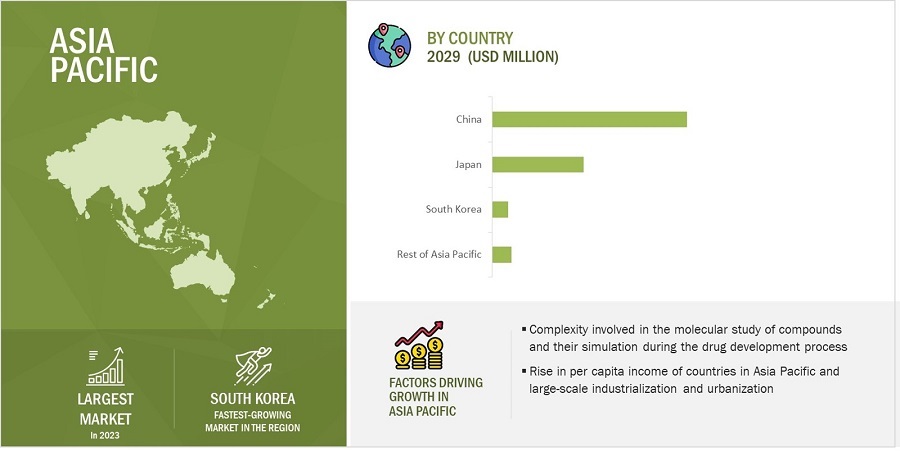
Quantum Computing Market by Region
To know about the assumptions considered for the study, download the pdf brochure
Key Market Players
The quantum computing companies is dominated by a few globally established players such IBM (US), D-Wave Quantum Inc. (Canada), Microsoft (US), Amazon Web Services (US), Rigetti Computing (US), Fujitsu (Japan), Hitachi (Japan), Toshiba (Japan), Google (US), Intel (US), Quantinuum (US), Huawei (China), NEC (Japan), Accenture (Ireland), Nippon Telegraph and Telephone (Japan), Bosch (Germany), Quantum Computing Inc (US), IonQ (US), QC Ware (US), PsiQuantum (US), Alpine Quantum Technologies GmbH (Tyrol), Xanadu (Canada), Zapata Computing (US), and Northrop Grumman (US).
Recent Developments
- In February 2024, D-Wave has made their 1,200+ qubit Advantage prototype available via their Leap real-time quantum cloud service. This allows existing Leap subscribers to gain immediate access to the new hardware, and new users can sign up for Leap and receive up to one minute of complimentary use of the Advantage2 prototype alongside other quantum processing units (QPUs) and solvers offered by the platform
- In November 2023, Rigetti Computing has secured Phase 2 funding from DARPA (Defense Advanced Research Projects Agency). These USD 1.5 million (potential) grants will support Rigetti in developing benchmarks to measure the performance of large-scale quantum computers for real-world applications.
Frequently Asked Questions (FAQs):
How big is the quantum computing Market?
The quantum computing market was valued at USD 899 million in 2023. The growth of the Internet penetration rate is increasing the demand for quantum computing across different verticals during the forecast period.
Are quantum computing in Demand?
Quantum computing is in demand, primarily because it can solve complex problems practically impossible for classical computers. Industries such as finance, pharmaceuticals, materials science, cryptography, and logistics are particularly interested in leveraging quantum computing for optimization, simulation, and cryptography tasks.
What are the various verticals of the quantum computing market?
Banking and finance are vertical to showcase the largest market size during the forecast period.
What region is expected to have a high adoption of the quantum computing market?
Asia Pacific is expected to lead the market during the forecast period.
Who is the Leader in the quantum computing market?
D Wave Quantum Inc. (Canada) is a key player in the quantum computing market. The company is also one of the leading providers globally, relying on its R&D capabilities and balanced product portfolio.
To speak to our analyst for a discussion on the above findings, click Speak to Analyst
The study involved four major activities in estimating the size of the quantum computing market. Exhaustive secondary research has been done to collect information on the market, peer market, and parent market. Validation of these findings, assumptions, and sizing with industry experts across the value chain through primary research has been the next step. Both top-down and bottom-up approaches have been employed to estimate the global market size. After that, market breakdown and data triangulation have been used to estimate the market sizes of segments and subsegments.
Secondary Research
Secondary sources for this research study include corporate filings (such as annual reports, investor presentations, and financial statements), trade, business, and professional associations, white papers, certified publications, articles from recognized authors, directories, and databases. Secondary data was collected and analysed to determine the overall market size, further validated by primary research.
Primary Research
Extensive primary research was conducted after understanding and analysing the quantum computing market scenario through the secondary research process. Several primary interviews were conducted with key opinion leaders from the demand- and supply-side vendors across four major regions—North America, Asia Pacific, Europe, and RoW (including the Middle East, Africa, and South America). After interacting with industry experts, brief sessions were conducted with highly experienced independent consultants to reinforce the findings from our primary. This, along with the in-house subject matter experts’ opinions, has led us to the findings as described in the remainder of this report.
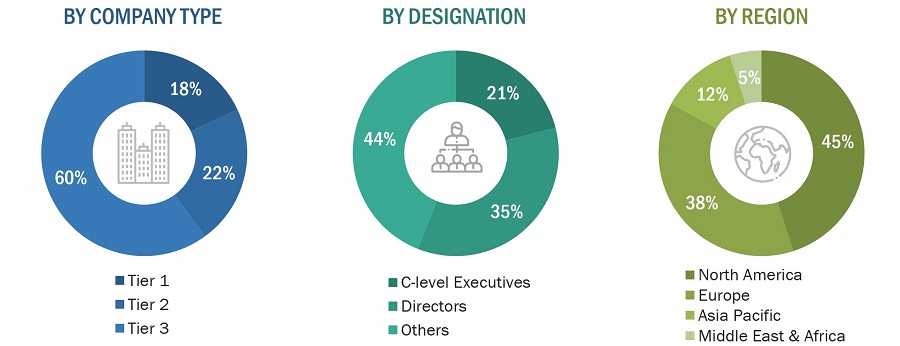
To know about the assumptions considered for the study, download the pdf brochure
Market Size Estimation
Both top-down and bottom-up approaches have been used to estimate and validate the total size of the quantum computing market. These methods have also been extensively used to estimate the sizes of various market subsegments. The research methodology used to estimate the market sizes includes the following:
- Identifying various applications that use or are expected to use the quantum computing market.
- Analyzing historical and current data pertaining to the size of the quantum computing market for each application
- Analyzing the average selling prices of quantum computing based on different technologies
- Studying various paid and unpaid sources, such as annual reports, press releases, white papers, and databases
- Identifying leading providers of quantum computing, studying their portfolios, and understanding features of their products and their underlying technologies, as well as the types of quantum computing products offered
- Tracking ongoing and identifying upcoming developments in the market through investments, research and development activities, product launches, expansions, and partnerships, and forecasting the market size based on these developments and other critical parameters
- Carrying out multiple discussions with key opinion leaders to understand the technologies used in quantum computing, and products wherein they are deployed, and analyze the break-up of the scope of work carried out by key manufacturers of quantum computing providers
- Verifying and crosschecking estimates at every level through discussions with key opinion leaders, such as CXOs, directors, and operations managers, and finally with domain experts at MarketsandMarkets
Market Size Estimation Methodology-Bottom-Up Approach

Data Triangulation
After arriving at the overall market size-using the market size estimation processes explained above-the market has been split into several segments and subsegments. To complete the overall market engineering process and arrive at the exact statistics of each market segment and subsegment, data triangulation, and market breakdown procedures have been employed, wherever applicable. The data has been triangulated by studying various factors and trends from both the demand and supply sides.
Market Definition
Quantum computing involves phenomena such as quantum entanglement and quantum mechanics superposition that are used by quantum computers for their enhanced computing power. The improved computing power of quantum computers can be attributed to how data is represented. Conventional computers use bits that can either be 1s or 0s, while quantum computers use qubits (quantum bits), which can be both 0s and 1s simultaneously due to superposition. Quantum computing devices or quantum computers operate with nanoscale components at low temperatures, and they have the potential to address some of the most challenging computational problems.
Key Stakeholders
- Research organizations and universities
- Original equipment manufacturers (OEMs)
- Technology standard organizations, forums, alliances, and associations
- Analysts and strategic business planners
- Government bodies, venture capitalists, and private equity firms
- End users
Report Objectives
- To define, describe, segment, and forecast the quantum computing market, in terms of value based on offering, deployment, technology, application, end-user, and region.
- To forecast the size of the market and its segments concerning four main regions, namely, North America, Europe, Asia Pacific, and the Rest of the World (RoW), along with their key countries
- To provide detailed information regarding the key factors influencing market growth, such as drivers, restraints, opportunities, and challenges
- To provide a detailed analysis of the quantum computing value chain
- To analyze the opportunities in the market for stakeholders and provide a detailed competitive landscape of the market leaders
- To strategically profile the key players and comprehensively analyze their market ranking and core competencies
- To analyze key growth strategies such as expansions, contracts, joint ventures, acquisitions, product launches and developments, and research and development activities undertaken by players operating in the quantum computing market.
Available Customizations:
With the given market data, MarketsandMarkets offers customizations according to the specific requirements of companies. The following customization options are available for the report:
Company Information
- Detailed analysis and profiling of 25 market players



 Generating Response ...
Generating Response ...







Growth opportunities and latent adjacency in Quantum Computing Market
I have a specific Interest in Commercialisation of quantum technologies
Interested in learning more about the quantum computing market.
Photonics application for quantum computer qbit device fabrication
To gain an insight of the economic perspectives of quantum computing, as an essential part of scientific planning (I am a professional physicist working in superconductivity)
Quantum simulation market size over years, use cases, most promising approaches.